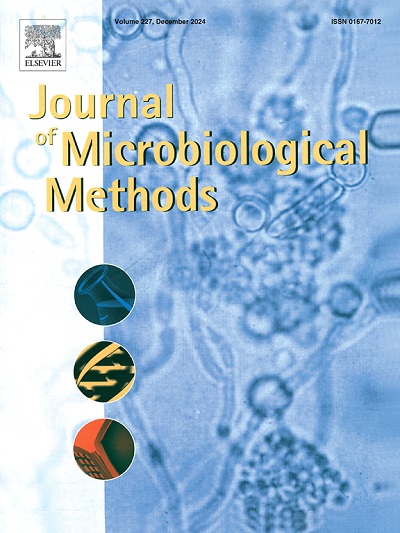开发一种基于金纳米粒子的比色法,用于快速检测细菌总数和大肠菌群的分子杂交方法
IF 1.9
4区 生物学
Q4 BIOCHEMICAL RESEARCH METHODS
引用次数: 0
摘要
总细菌计数(TBC)和大肠菌群已被作为食品微生物质量和粪便污染的指标,它们的检测是大多数国家为保证食品安全而制定的微生物学标准。本研究采用分子杂交方法,建立了一种基于金纳米粒子(AuNPs)的TBC和大肠菌群快速检测比色法。设计巯基修饰的引物SH-27F和SH-lacZF与AuNPs偶联,作为杂交探针和信号探针,以盐诱导的AuNPs聚集作为杂交和检测的指示物。本研究以大肠杆菌为模型菌株。结果表明,在最佳条件下,TBC和大肠菌群的检出限分别为102 CFU/mL和101 CFU/mL,紫外-可见光谱分析的检出限分别为101 CFU/mL,使用智能手机应用ColorPicker进行定量分析。在101 ~ 104 CFU/mL范围内,颜色信号与大肠杆菌浓度呈良好的线性关系。该检测方法快速、简便、灵敏,无需培养富集和贵重设备,在TBC和大肠菌群的现场检测中具有良好的应用潜力。此外,该策略为其他病原微生物的高灵敏度比色信号探针的设计提供了方向。本文章由计算机程序翻译,如有差异,请以英文原文为准。
Development of a gold nanoparticle-based colorimetric assay for rapid detection of total bacterial count and coliform bacteria using the molecular hybridization approach
Total bacterial counts (TBC) and coliforms bacteria have been used as the index of microbial quality and fecal contamination for foods, the detection of them is involved in microbiological criteria of most countries to guarantee food safety. In this study, a gold nanoparticle (AuNPs) based colorimetric assay for rapid detection of TBC and coliform bacteria was developed by using the molecular hybridization approach. Thiol modified primers SH-27F and SH-lacZF were designed and conjugated with AuNPs, which was acted as both hybridization probe and signal probe, and salt induced aggregation of AuNPs was indicator of the hybridization and detection. Escherichia coli was studied as model strain in this study. The result showed that under the optimal conditions, the limit of detection for TBC and coliforms bacteria were 102 CFU/mL and 101 CFU/mL by visual detection, and 101 CFU/mL by UV–vis spectrum analysis, a smart phone application named ColorPicker was used for the quantitative analysis of the colorimetric assay. The colour signal had good linear relationship of E. coli concentration in the range of 101–104 CFU/mL. The detection is rapid, simple and sensitive, without the needing of culture enrichment and precious equipment, has good application potential for the on-site detection of TBC and coliforms bacteria. In addition, the proposed strategy provides a direction for the design of highly sensitive colorimetric signal probes for other pathogenic microorganisms.
求助全文
通过发布文献求助,成功后即可免费获取论文全文。
去求助
来源期刊

Journal of microbiological methods
生物-生化研究方法
CiteScore
4.30
自引率
4.50%
发文量
151
审稿时长
29 days
期刊介绍:
The Journal of Microbiological Methods publishes scholarly and original articles, notes and review articles. These articles must include novel and/or state-of-the-art methods, or significant improvements to existing methods. Novel and innovative applications of current methods that are validated and useful will also be published. JMM strives for scholarship, innovation and excellence. This demands scientific rigour, the best available methods and technologies, correctly replicated experiments/tests, the inclusion of proper controls, calibrations, and the correct statistical analysis. The presentation of the data must support the interpretation of the method/approach.
All aspects of microbiology are covered, except virology. These include agricultural microbiology, applied and environmental microbiology, bioassays, bioinformatics, biotechnology, biochemical microbiology, clinical microbiology, diagnostics, food monitoring and quality control microbiology, microbial genetics and genomics, geomicrobiology, microbiome methods regardless of habitat, high through-put sequencing methods and analysis, microbial pathogenesis and host responses, metabolomics, metagenomics, metaproteomics, microbial ecology and diversity, microbial physiology, microbial ultra-structure, microscopic and imaging methods, molecular microbiology, mycology, novel mathematical microbiology and modelling, parasitology, plant-microbe interactions, protein markers/profiles, proteomics, pyrosequencing, public health microbiology, radioisotopes applied to microbiology, robotics applied to microbiological methods,rumen microbiology, microbiological methods for space missions and extreme environments, sampling methods and samplers, soil and sediment microbiology, transcriptomics, veterinary microbiology, sero-diagnostics and typing/identification.
 求助内容:
求助内容: 应助结果提醒方式:
应助结果提醒方式:


